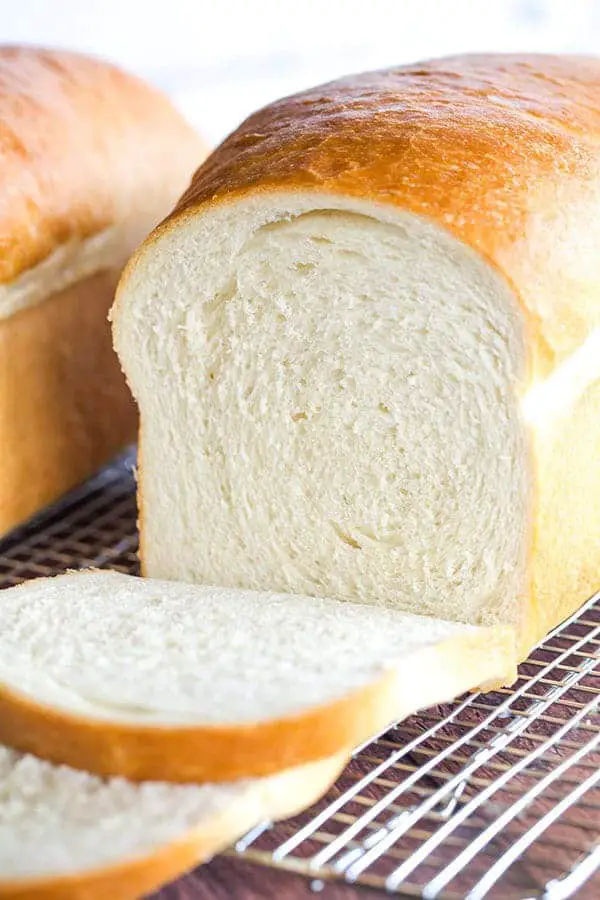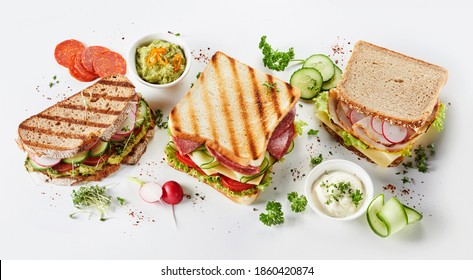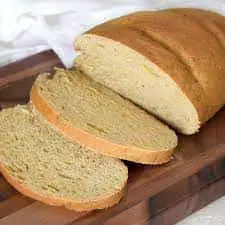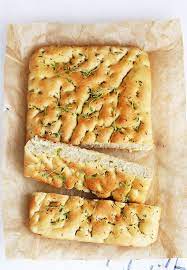In this post we will be looking at : Parts of Sandwich, Types of Sandwich Fillings, Selection of Sandwich bread
A sandwich is a food typically consisting of vegetables, sliced cheese or meat, placed on or between slices of bread, or more generally any dish wherein bread serves as a container or wrapper for another food type. The sandwich is the stalwart staple of the American lunch.
Origin
The bread-enclosed convenience food known as the word sandwich may have originated from a story about John Montagu, the 4th Earl of Sandwich. He didn’t really ‘invent’ the sandwich but he may have made it popular.
It is said that in approx 1762, he asked for meat to be served between slices of bread, to avoid interrupting a gambling game. This story may have been a rumor or adverse propaganda, put about by his rivals.
But soon people may have started ordering “the same as Sandwich”, and the name stuck!
The First ‘Sandwiches’
The 1st Century B.C. Jewish Rabbi Hillel the Elder is reported to have started the Passover tradition of putting lamb, mixed nuts and herbs between two pieces of unleavened bread. In the Middle Ages, people used thick slices of stale bread called ‘trenchers’ to double as plates on which they placed cooked meats and vegetables, a kind of ‘open sandwich’, although they probably did not eat the stale bread. The Dutch also have a long tradition of serving bread & butter with meat or fish or other delicious fillings & toppings.
Parts of Sandwich
The four parts of a sandwich can be listed as:
- Bread
- Spread
- Filling
- Garnish
Breads
Various types of bread can be used to make sandwiches. The type of bread has a dramatic effect on the finished fare. The quality of the bread also has a great impact on the quality and taste of the final product.
Sandwich bread (also referred to as sandwich loaf) is the bread that is prepared specifically to be used for the preparation of sandwiches.
Types of Sandwich Bread
Sandwich breads are produced in many varieties, such as white, whole wheat, sourdough, rye, multigrain and others. Sandwich bread may be formulated to slice easily, cleanly or uniformly, and may have a fine crumb (the soft, inner part of bread) and a light texture.
Let’s look at some types of bread used in sandwiches:
Rye Bread
When the Dutch and English settled in what would become the United States, they introduced rye to the region. Bakers combine rye with wheat flour to make rye bread. There are a number of rye bread types available in the grocery store, such as Jewish rye, Russian rye and marbled rye.
Sourdough
A sandwich with a burger patty filling, named The Frisco Burger, got its name from its sourdough, which is associated with San Francisco. Reports say Egyptians discovered the process of making sourdough bread. Sourdough comes from the starter, which comes from a previous batch of bread. Starter dough originated over a century earlier. Sourdough is not like white bread, which is fluffy and soft, rather sourdough is a firm, chewy and crusty bread.
Focaccia Bread
Focaccia is an ancient flatbread. Previously the bread was unleavened, but today bakers add a leavening ingredient to the dough, such as yeast. Bakers enrich the bread dough with cheeses and herbs, to give focaccia bread a distinct flavor and texture. The focaccia becomes a dominate taste factor in a sandwich in comparison to other bread, such as plain white or wheat bread.
Pita

The round and flat pita is a type of unleavened bread popular in the Mediterranean and Middle Eastern cuisines. Once split in half, the soft and mildly flavored bread reveals a pocket that can hold a variety of meat fillings, vegetables, and sauces.
White Bread or Whole Wheat Bread

White bread or whole wheat bread typically refers to breads entirely made from wheat flour. This is widely available and commonly used bread for sandwiches.
Brown Bread
Brown bread is a designation often given to breads made with significant amounts of whole grain flour, usually wheat, and sometimes dark-colored ingredients such as molasses or coffee. It is also a commonly used sandwiches bread.
Selection of Bread
The breads used for making sandwiches must be chosen carefully.
- Always select fresh bread that has a close smooth crumb and good flavor and moistness.
- The bread should be capable of being picked up without bending or losing the filling.
- Bread should be around 12 hours old when making sandwiches otherwise it will be too soft.
- 3/8 “to 5/8” is the thickness range most commonly used for sandwiches.
Storage And Handling Of Bread
- Purchase only the amount of bread that can be used in one day.
- If excess bread is purchased, old and new supplies should be separated each day. Old bread should be set aside for toasting and grilling.
- Store soft crusted bread in its original wrapper to protect against odor absorption, moisture loss or excessive dampness.
- Hard-crusted breads may be stored without wraps in the area which has free air circulation. These breads have a shorter storage life.
- Refrigerating bread makes it stale. If it is to be kept for more than one day it should be frozen.
- Bread is best stored at room temperature at 68-80 °F, away from heat.
types of sandwich spreads

A sandwich spread is a spreadable condiment used in a sandwich, in addition to more solid ingredients.
Function
The main function of the spread is to hold the filling and the bread together. It also forms a protective layer on the bread and prevents it from getting soggy from the moisture in the filling. Moreover, it adds to the taste of the sandwich and in the case of children, contributes to the nutritive value.
Some of the spreads are:
- Plain and compound butter like anchovy, herb, parsley butter
- Mayonnaise and its derivatives
- Low fat spreads like margarine
- Cheese spreads and cheese paste
- A combination of the above.
Storage And Handling
Many sandwich spreads can be at risk of spoiling quickly, which should be completely avoided.
Spreads such as peanut butter and jam can last for up to a year after they’ve been opened, but oxygen can go a long way in spoiling them earlier than expected so keeping bottle tightly closed will protect it from early spoiling.
Spreads should be stored under refrigeration to inhibit microbial growth. Mayonnaise if commercially procured should be refrigerated on
opening the bottle. Cross-contamination should be avoided while using the spread as it makes spreads more prone to spoil early.
Types of Sandwich Filling

It could be a variety of limitless items. The filling gives the sandwich its name.
Fillings could include meat, poultry, fish, eggs, cheese, vegetables. Salami, cooked roast chicken, ox tongue, sliced cucumber and tomato are all popular fillings.
The filling could be a single item or a combination of several. Ham and cheese, Cucumber and chutney, Bacon and tomato. It is important that the combinations are complementary to each other.
List of fillings for Sandwich Garnishes
Below we have shared what are the types of sandwich spreads
Cold Meats
Ham
Ham & Pickle
Ham Salad
Ham & Lettuce
Ham, Lettuce & Beetroot
Ham & Tomato
Ham & Avocado
Ham & Houmous
Ham & Cheddar Cheese
Ham & Cream Cheese
Ham & Coleslaw
Ploughmans
Sausage
Sausage Sloppy Joes
German Sausage Slices
Sliced Pepperoni
Pepperoni & Cheese
Fig & Prosciutto
Bacon
Bacon, Lettuce & Tomato
Brie & Bacon
Cheddar & Bacon
Goats Cheese & Bacon
Pulled Lamb
Pulled Pork
Roast Beef
Roast Beef Salad
Steak Salad
Philly Cheese Steak
Corned Beef
Corned Beef & Pickle
Poultry
Chicken
Chicken & cranberry sauce
Chicken & Sweet Chilli Jam
Chicken Salad
Chicken & bacon salad
Chicken & bacon
Chicken & Sweetcorn
Chicken & Avocado
Fruity Chicken Salad with Tarragon Yoghurt Dressing
Chicken Tikka
Chicken Tikka with Sliced Onion Bhaji
Chicken Tikka Salad
Chicken Tikka with Yoghurt & Mango Chutney
Chicken Greek Salad
BBQ Pulled Chicken
Coronation Chicken
Malibu Chicken
Turkey
Turkey Salad
Turkey Egg Salad
Turkey & Cranberry Sauce
Turkey with Black Bean Spread
Turkey & Pickled Red Cabbage
Turkey Argula
Duck Salad with Plum Sauce
Egg
Egg Mayo
Egg Mayo + Bacon
BLT Egg Salad
Egg Salad
Avocado Egg
Egg & Cress
Fish/Seafood
Tuna Mayo
Tuna & Cucumber
Tuna & Sweetcorn
Tuna & Spring onion
Tuna Salad (recipe from You Brew My Tea)
Smoked Salmon & Cream Cheese
Prawn Mayo
Prawn Mayo Salad
Cheese
Cheese & Mango Chutney
Cheese & Onion
Cheese & Cranberry Sauce
Green Goddess
Cream Cheese
Cream Cheese & Marmite
Pizza Cream Cheese
Cream Cheese & Cucumber
Cream Cheese & Grated Carrot
Cream Cheese & Raspberries
Cream Cheese & Grapes
Cream Cheese & Jam
Cream Cheese & Pineapple
Cottage Cheese Salad
Cottage Cheese & Pineapple
Garlic (roule) cheese
Smoked Cheese & Mango Chutney
Grilled Cheese Pizza Sandwich
Cheddar Cheese
Cheddar Cheese & Pickle
Cheddar & Sliced Tomato
Cheddar & Grapes
Cheddar & Marmite
Cheddar & Apple
Cheddar, Apply & Spring Onion
Cheddar & Marmalade
Cheese & Pear Ploughmans
Pear & Goats Cheese
Goat’s Cheese, Walnuts & Honey
Halloumi with Avocado Pea & Mint Pesto
Brie & Cranberry
Brie & Grape
Brie & Avocado
Grilled Nutella Cheese
Other Vegetarian Filling
California Veggie Sandwich
Tofu Bacon BLT
Veggie Sausage, Red Pepper & Hummus
Avocado & Salad
Avocado & Banana
Grated Carrot & Raisins
Bombay Sandwich
Vegan Chickpea Mayo
Chickpea Salad
Avocado Chickpea Salad
Falafel Salad
Honey
Jam
Chocolate Spread
Chocolate Spread & Strawberries
Chocolate Spread & Banana
Chocolate Spread & Jam
Chocolate Hummus
Banana & Chocolate Spread
Purpose of filling
- The predominant flavor
- Moisture
- The main body and the nutrients
- Substance and bulk
- Complexity in the combination of flavors
Guidelines for filling
- 1/3 to 1/2 of the total weight of the sandwich should be the filling.
- The filling should be pleasantly flavored.
- The filling must be tender in nature.
- The filling should always be of deboned meats and not bone-in
- Fillings must be easy to eat
- Fillings should not hang over the sides of the sandwich
Garnish
To enhance the appearance and the presentation of the sandwich, it is necessary to create eye appeal. The garnish is not absolutely essential and can be avoided in an informal setting. The garnish should be delicate and dainty and not cumbersome and ugly.
How to Garnish Sandwiches
For a natural or healthy look to sandwiches, we can use Use green garnishes. Lettuce, parsley, spinach, and arugula are the common option of adding greens to sandwiches. Garnish a platter with asparagus, celery or sliced cucumber to give guests the option of an extra crunch to go along with their sandwich. Pickles and olives have strong flavors but fit well with any deli-meat sandwich platter.
We can garnish a sandwich platter with red foods to enhance taste and appearance. Using cherry or grape tomatoes, radishes or beets to add color to any sandwich platter is a great option.
Adding yellow foods to a sandwich platter give it a bright look. Yellow cheeses will go well and match perfectly with meat sandwiches. We can use lemon rind or egg yolk to give some color to a green garnish.
The sandwich is without a doubt a favorite lunchtime food. For the typical customer, one who is hungry and in a hurry, the sandwich is the ideal food; quickly made and served, convenient and adaptable to many variations, that it satisfies nearly every palate and nutrition requirement. Sandwiches have long been the domain of the pantry department, along with salads and other cold dishes. Preparing sandwiches to order is one of the fundamental skills required in modern food service.
Keywords of This Topic : Parts of Sandwich, Types of Sandwich Fillings, Selection of Sandwich bread
You might be intrested in : The Ultimate Guide to Sandwiches PDF Included






indian pharmacies safe https://indiaph24.store/# best india pharmacy
cheapest online pharmacy india
medication from mexico pharmacy [url=https://mexicoph24.life/#]purple pharmacy mexico price list[/url] mexican mail order pharmacies
best online pharmacies in mexico: mexican pharmacy – mexico drug stores pharmacies
top 10 pharmacies in india [url=https://indiaph24.store/#]buy medicines from India[/url] world pharmacy india
https://lisinopril.network/# buy lisinopril online india
tamoxifen hip pain [url=https://nolvadex.life/#]tamoxifen mechanism of action[/url] is nolvadex legal
aromatase inhibitor tamoxifen: tamoxifen therapy – natural alternatives to tamoxifen
aromatase inhibitors tamoxifen [url=https://nolvadex.life/#]nolvadex for sale amazon[/url] nolvadex pct
http://finasteride.store/# generic propecia pill
http://lisinopril.network/# lisinopril 40 mg cost
antibiotics cipro: buy cipro online canada – cipro
http://ciprofloxacin.tech/# cipro
buy cytotec pills online cheap [url=https://cytotec.club/#]buy cytotec online[/url] buy cytotec over the counter
http://lisinopril.network/# zestoretic medication
tamoxifen for men: nolvadex online – who should take tamoxifen
tamoxifen vs raloxifene [url=https://nolvadex.life/#]low dose tamoxifen[/url] nolvadex pct
https://nolvadex.life/# benefits of tamoxifen
https://finasteride.store/# buying generic propecia without prescription
tamoxifen postmenopausal [url=https://nolvadex.life/#]low dose tamoxifen[/url] tamoxifen side effects forum
buy generic ciprofloxacin [url=https://ciprofloxacin.tech/#]ciprofloxacin order online[/url] ciprofloxacin generic price
get generic propecia online: cost of propecia without prescription – propecia generic
purchase cytotec [url=http://cytotec.club/#]buy cytotec online fast delivery[/url] buy cytotec online
buy cipro cheap: cipro for sale – cipro online no prescription in the usa
buy nolvadex online [url=https://nolvadex.life/#]does tamoxifen cause bone loss[/url] tamoxifen and bone density
https://nolvadex.life/# nolvadex generic
how much is 30 lisinopril: can i buy lisinopril over the counter in mexico – lisinopril average cost
https://finasteride.store/# cost cheap propecia for sale
Misoprostol 200 mg buy online [url=https://cytotec.club/#]buy cytotec[/url] buy cytotec pills
lisinopril 20 mg price online [url=http://lisinopril.network/#]price of lisinopril 30 mg[/url] lisinopril pill 20mg
buy cytotec over the counter: cytotec pills buy online – buy misoprostol over the counter
https://ciprofloxacin.tech/# ciprofloxacin generic
http://ciprofloxacin.tech/# ciprofloxacin
buy cytotec over the counter: buy cytotec online – purchase cytotec
http://finasteride.store/# order cheap propecia without a prescription
buy lisinopril online [url=https://lisinopril.network/#]lisinopril 10 mg[/url] lisinopril australia